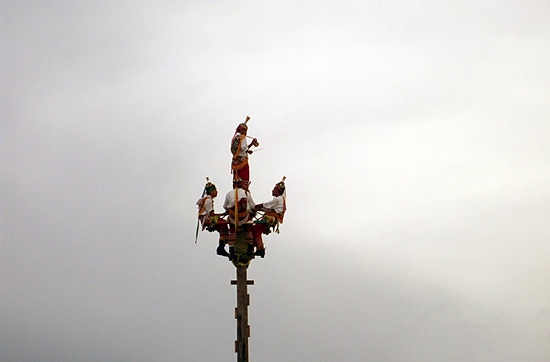Folk Fest kicks off with Mayan dance staged on a 80-foot pole
It’s one of the coolest things you’ll see at the Folk Festival…and probably in your entire life.

Five men scale an 80-foot wooden pole. One man dances and plays the flute on top before the other four, sitting on a square platform, suddenly lunge backwards and spiral to the ground with the support of only a single rope affixed to one leg.
“It’s jaw-dropping,” says Julia Olin, executive director at the National Council for the Traditional Arts about the Danza de los Voladores (Dance of the Flyers). “It’s both amazing and rather terrifying.”
The Cirque du Soleil-like spectacle, also known as a Mayan Sun Dance, dates back between 250 – 900 AD. “It’s an ancient ritual from Mesoamerica,” Olin said, likely originating during the Mayan and later Aztec empires.
Christopher Columbus witnessed the sun dance in present day Southern Mexico during his fourth voyage in 1502 and is the first European to document the dance.
“As with many ancient traditions, there are quite a number of different ways people write about, talk about, and interpret what it was and what it is,” Olin said. That’s why the original purpose of the dance remains ambiguous. “There are some legends that it began as a ritual to plead with the gods to end a drought, with the pole representing the connection of heaven and earth, as a sort of sun dance,” she said. “Certain things about the ritual definitely can be traced to Aztec times. Each volador circles the pole 13 times, each one, for a total of 52 circuits, which is the number of years in the Aztec Calendar Round.”
Anthropologists believe the dance originated in what is now Veracruz, Mexico before spreading across Central America. Performers at this year’s Richmond Folk Festival reside in Veracruz, epicenter of the tradition.
More remarkable than sun dance’s acrobatics is its survival through Spanish imperialism. “The Spanish [1527 – 1547 AD] did try to suppress this tradition, and any other traditions that were related to religious rituals that were not Christian,” Olin said. “According to what I know, the ritual was partly lost after the conquest, and the Spanish destroyed all the records.”
Olin said locals amalgamated Catholic elements into sun dance in response to their changing culture. “Originally, the participants would have been dressed as birds,” Olin said. “Over the centuries, that’s changed, and you can see in their clothing now Hispanic influences and others…so it’s changed over time.”
Some Central American communities still regard the sun dance as a profound spiritual act. But others have recognized the dance as a tourist attraction. “Instead of the wooden pole, you may find a metal pole that’s permanently installed,” Olin said about those communities.
But the Tezcatlipoca Voladores don’t abide in heavy metal, opting for the traditional wood pole when performing the sun dance. Folk Festival organizers have commissioned a 10-foot hole dug near this year’s Altria Stage that will support the pole.
“The flyers will be coming in a number of days early because they need to be present when the pole is raised, and the pole needs to be blessed,” Olin said.
Blessing the pole requires a live chicken, which Folk Festival organizers learned when the voladores first performed at Folk Festival in 2008. “Last time they were here, folks had to go out and get a chicken,” Olin said. “It had to be a woman that held the chicken and then moved the chicken around the hole upside down…to bless it.”
Here’s video of the pole’s blessing from 2008:
“I’m happy to say the chicken was not actually sacrificed. The chicken was returned to its chicken home after the event, but [it] was out there pecking around and on site for several days.”
The voladores rely on ropes to both perform the sun dance and for their safety. “They wrap the rope around the pole, and there’s another rope around the pole in such a way that you could use it as a foot hole to climb up. They don’t even have ordinary, wooden horizontal foot holes,” Olin said. “It’s almost like some crazy, giant maple [tree] with bungee jumpers on it.”
Four “flyers” ascend the pole, followed by the priest who performs for the Divine by playing a flute representing lightening while dancing on a drum representing Earth’s heartbeat. “At one moment, [the flyers] flip over backwards off the platform and then spin around, spiraling all the way down to the ground,” Olin said.
Here’s video of their 2008 performance:
The acrobatics and cultural endurance of Danza de los Voladores makes it “one of the heritage treasures of the world,” Olin said. In 2009, the dance was inscribed to the list of Intangible Cultural Heritage of Humanity by the United Nations Educational, Scientific, and Cultural Organization. “It’s only the second Mexican tradition to receive this designation.”
The historical and cultural gravity of the dance the voladores routinely defy dazzled Folk Festival organizers six years ago. “It’s something festival organizers were very committed to bringing back to celebrate the 10th anniversary,” Olin said.
She encourages everyone to watch the dance when it opens this year’s festival at the Altria Stage on Friday, October 10th at 6:30 PM. “It’s a rare opportunity,” she said.
BESbswyBESbswyBESbswyBESbswy
Photo of Mexican voladores by Ivette Quiñónez
-
Recommend this
on Facebook -

Report an error
-

Subscribe to our
Weekly Digest





Notice: Comments that are not conducive to an interesting and thoughtful conversation may be removed at the editor’s discretion.